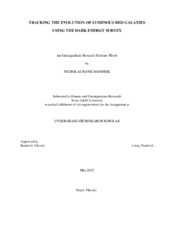| dc.description.abstract | Galaxies form the fundamental building blocks of the large scale structure of the universe. As such, understanding their formation and evolution plays a key role in determining how our universe evolved to its present state. We present in this thesis an analysis of the mass and color evolution (from $z=0.1$ to $z=1$) of a subset of galaxies called luminous red galaxies (LRGs) taken from the Dark Energy Survey. LRGs are the most massive galaxies found in the nearby universe, and typically reside in galaxy clusters. Their red colors indicate that they are dominated by old stellar populations, with most forming just a few billion years after the big bang. Data from the Dark Energy Survey allows us to sample the growth of LRGs in a large portion of the sky (5000 sq. deg.) over half the lifetime of the universe. We find that most LRGs in our sample have a mass between $10^{10}$ and $10^{11}$ solar masses. We also find that the color evolution is well modeled by a simple stellar population with a formation redshift of between z = 5 and z = 3, except in the $g-r$ color. We also explore the differences between observed and theoretical evolutionary models, which could be caused by model deficiencies or progenitor bias in our galaxy sampling. | en |


